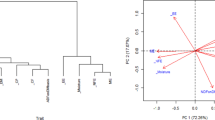Abstract
Two species ofEchinochloa millets and their direct wild ancestor species were analyzed for proximate composition, and amino acid, calcium, and iron content. Additionally, lactate polyacrylamide gel electrophoresis (PAGE) was performed to separate and resolve prolamin polypeptide present in the wild and domesticated species. The protein, calcium, and iron content of the four species were comparable to or greater than in other major cereals. Calcium was higher in each of the wild species than their domesticated counterpart. Essential amino acid values for the three species analyzed were generally higher than the FAO/WHO standards, except for lysine. Densitometric analysis of lactate PAGE gels revealed that the domesticated species contained prolamin polypeptides that were either absent or present in smaller amounts in the wild species. The results indicate a wide variation in the content of examined nutrients and suggest that there is opportunity for improvement in the nutritional value of theEchinochloa millets via selective crossbreeding of wild and domesticated species.
Similar content being viewed by others
References
Bor NL (1960) Grasses of Burma, Ceylon, India and Pakistan. Pergamon Press.
Yabuno T (1966) Biosystematic study of the genusEchinochloa. Jap Bot 19: 277–323.
de Wet JMJ, Rao KE, Prasada, Mengesha MH, Brink DE (1983) Domestication of Sawa millet (Echinochloa colona). Economic Botany 37: 283–291.
de Wet JMJ (1989) Origin, evolution and systematics of minor cereals. In: Seetharam A, Riley KW, Harinarayana G (eds), Small millets in global agriculture. New Delhi: Oxford & IBH Publishing Co., pp. 19–30.
Mahjid MA, Hamid MA, Mannujan (1989) Importance, genetic resources and breeding of small millets in Bangladesh. In: Seetharam A, Riley KW, Harinarayana G (eds), Small millets in global agriculture. New Delhi: Oxford & IBH Publishing Co., pp. 71–76.
Purseglove JW (1972) Tropical crops: Monocotyledons I. London: Longman.
Hilu KW (1994) Evidence from RAPD markers in the evolution ofEchinochloa millets (Proaceae). Pl Syst Evol 189: 247–257.
Duke JA, Atchley AA (1986) Handbook of proximate analysis tables of higher plants. Boca Raton: CRC Press.
AOAC (1980) Official Methods of Analysis, 13th ed. Washington, DC: American Association of Official Analytical Chemists, pp. 858.
Jones DB (1931) Factors for converting percentages in nitrogen in foods and feeds into percentages of protein. US Dept, of Agr Circ No. 183.
Lookhart GL, Jones BL, Hall SB, Finney KF (1982) An improved method for standardizing polyacrylamide gel electrophoresis of wheat gliadin proteins. Cereal Chemistry 59: 178.
Lookhart GL, Albers LD, Bietz JA (1986) Comparison of polyacrylamide gel electrophoresis and high-performance liquid chromotography analysis of gliadin polymorphism in the wheat cultivar ‘Newton’. Cereal Chemistry 63: 497–500.
Wu VY, Inglett GE (1988) Effects of agricultural practices, handling, processing, and storage on cereals. In: Karmas E, Harris RS (eds), Nutritional evaluation of food processing. New York: Van Nostrand Reinhold Co., pp. 101–108.
Johnson VA, Lay CL (1974) Genetic Improvement of Plant Protein. J Agr Food Chem 22(4): 558–566.
Esen A, Hilu KW (1993) Prolamin and immunological studies in the Poaceae, IV: Subfamily Panicoideae. Can J Bot 71: 315–322.
Hilu KW, Esen A (1988) Prolamin size diversity in the Poaceae. Biochem Syst Ecol 16: 457–465.
USDA/ARS (1975) Nutritive value of American food in common units. Washington, DC: Agricultural Handbook, No. 456.
Clayton WD, Renvoize SA (1986) Genera Graminum. Kew: Royal Botanical Garden, Kew.
Author information
Authors and Affiliations
Rights and permissions
About this article
Cite this article
Mandelbaum, C.I., Barbeau, W.E. & Hilu, K.W. Protein, calcium, and iron content of wild and cultivated species ofEchinochloa . Plant Food Hum Nutr 47, 101–108 (1995). https://doi.org/10.1007/BF01089258
Received:
Accepted:
Issue Date:
DOI: https://doi.org/10.1007/BF01089258




